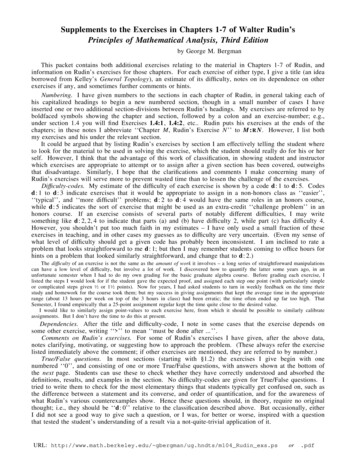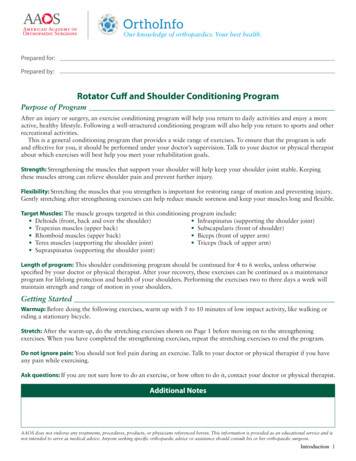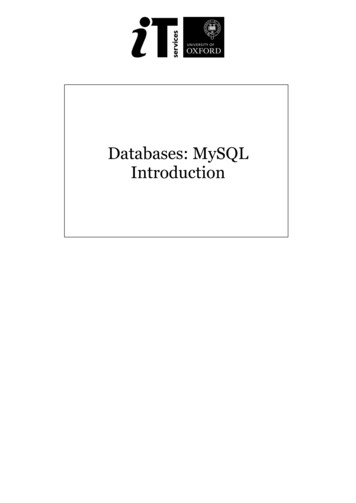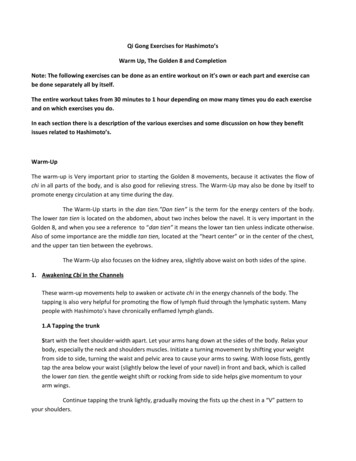
Transcription
Supplements to the Exercises in Chapters 1-7 of Walter Rudin’sPrinciples of Mathematical Analysis, Third Editionby George M. BergmanThis packet contains both additional exercises relating to the material in Chapters 1-7 of Rudin, andinformation on Rudin’s exercises for those chapters. For each exercise of either type, I give a title (an ideaborrowed from Kelley’s General Topology), an estimate of its difficulty, notes on its dependence on otherexercises if any, and sometimes further comments or hints.Numbering. I have given numbers to the sections in each chapter of Rudin, in general taking each ofhis capitalized headings to begin a new numbered section, though in a small number of cases I haveinserted one or two additional section-divisions between Rudin’s headings. My exercises are referred to byboldfaced symbols showing the chapter and section, followed by a colon and an exercise-number; e.g.,under section 1.4 you will find Exercises 1.4:1, 1.4:2, etc. Rudin puts his exercises at the ends of thechapters; in these notes I abbreviate ‘‘Chapter M, Rudin’s Exercise N ’’ to M : R N. However, I list bothmy exercises and his under the relevant section.It could be argued that by listing Rudin’s exercises by section I am effectively telling the student whereto look for the material to be used in solving the exercise, which the student should really do for his or herself. However, I think that the advantage of this work of classification, in showing student and instructorwhich exercises are appropriate to attempt or to assign after a given section has been covered, outweighsthat disadvantage. Similarly, I hope that the clarifications and comments I make concerning many ofRudin’s exercises will serve more to prevent wasted time than to lessen the challenge of the exercises.Difficulty-codes. My estimate of the difficulty of each exercise is shown by a code d: 1 to d: 5. Codesd: 1 to d: 3 indicate exercises that it would be appropriate to assign in a non-honors class as ‘‘easier’’,‘‘typical’’, and ‘‘more difficult’’ problems; d: 2 to d: 4 would have the same roles in an honors course,while d: 5 indicates the sort of exercise that might be used as an extra-credit ‘‘challenge problem’’ in anhonors course. If an exercise consists of several parts of notably different difficulties, I may writesomething like d: 2, 2, 4 to indicate that parts (a) and (b) have difficulty 2, while part (c) has difficulty 4.However, you shouldn’t put too much faith in my estimates – I have only used a small fraction of theseexercises in teaching, and in other cases my guesses as to difficulty are very uncertain. (Even my sense ofwhat level of difficulty should get a given code has probably been inconsistent. I am inclined to rate aproblem that looks straightforward to me d: 1; but then I may remember students coming to office hours forhints on a problem that looked similarly straightforward, and change that to d: 2.)The difficulty of an exercise is not the same as the amount of work it involves – a long series of straightforward manipulationscan have a low level of difficulty, but involve a lot of work. I discovered how to quantify the latter some years ago, in anunfortunate semester when I had to do my own grading for the basic graduate algebra course. Before grading each exercise, Ilisted the steps I would look for if the student gave the expected proof, and assigned each step one point (with particularly simpleor complicated steps given 1 2 or 11 2 points). Now for years, I had asked students to turn in weekly feedback on the time theirstudy and homework for the course took them; but my success in giving assignments that kept the average time in the appropriaterange (about 13 hours per week on top of the 3 hours in class) had been erratic; the time often ended up far too high. ThatSemester, I found empirically that a 25-point assignment regular kept the time quite close to the desired value.I would like to similarly assign point-values to each exercise here, from which it should be possible to similarly calibrateassignments. But I don’t have the time to do this at present.Dependencies. After the title and difficulty-code, I note in some cases that the exercise depends onsome other exercise, writing ‘‘ ’’ to mean ‘‘must be done after .’’.Comments on Rudin’s exercises. For some of Rudin’s exercises I have given, after the above data,notes clarifying, motivating, or suggesting how to approach the problem. (These always refer the exerciselisted immediately above the comment; if other exercises are mentioned, they are referred to by number.)True/False questions. In most sections (starting with §1.2) the exercises I give begin with onenumbered ‘‘0’’, and consisting of one or more True/False questions, with answers shown at the bottom ofthe next page. Students can use these to check whether they have correctly understood and absorbed thedefinitions, results, and examples in the section. No difficulty-codes are given for True/False questions. Itried to write them to check for the most elementary things that students typically get confused on, such asthe difference between a statement and its converse, and order of quantification, and for the awareness ofwhat Rudin’s various counterexamples show. Hence these questions should, in theory, require no originalthought; i.e., they should be ‘‘d: 0’’ relative to the classification described above. But occasionally, eitherI did not see a good way to give such a question, or I was, for better or worse, inspired with a questionthat tested the student’s understanding of a result via a not-quite-trivial application of it.URL: http://www.math.berkeley.edu/ gbergman/ug.hndts/m104 Rudin exs.psor.pdf
-2Terminology and Notation. I have followed Rudin’s notation and terminology very closely, e.g. usingR for the field of real numbers, J for the set of positive integers, and ‘‘at most countable’’ to describe aset of cardinality ℵ0 . But on a few points I have diverged from his notation: I distinguish betweensequences (si ) and sets {si } rather than writing {si } for both, and I use rather than forinclusion. I also occasionally use the symbols and , since it seems worthwhile to familiarize thestudent with them.Advice to the student. An exercise may only require you to use the definitions in the relevant section ofRudin, or it may require for its proof some results proved there, or an argument using the same method ofproof as some result proved there. So in approaching each problem, first see whether the result becomesreasonably straightforward when all the relevant definitions are noted, and also ask yourself whether thestatement you are to prove is related to the conclusion of any of the theorems in the section, and if so,whether that theorem can be applied as it stands, or whether a modification of the proof can give the resultyou need. (Occasionally, a result listed under a given section may require only material from earliersections, but is placed there because it throws light on the ideas of the section.)Unless the contrary is stated, solutions to homework problems are expected to contain proofs, even ifthe problems are not so worded. In particular, if a question asks whether something is (always) true, anaffirmative answer requires a proof that it is always true, while a negative answer requires an example of acase where it fails. Likewise, if an exercise or part of an exercise says ‘‘Show that this result fails ifsuch-and-such condition is deleted’’, what you must give is an example which satisfies all the hypothesesof the result except the deleted one, and for which the conclusion of the result fails. (I am not counting thetrue/false questions under ‘‘homework problems’’ in this remark, since they are not intended to be handedin; but when using these to check yourself on the material in a given section, you should be able to justifywith a proof or counterexample every answer that is not simply a statement taken from the book.)From time to time students in the class ask ‘‘Can we use results from other courses in our homework?’’The answer is, in general, ‘‘No.’’ Rudin shows how the material of lower division calculus can bedeveloped, essentially from scratch, in a rigorous fashion. Hence to call on material you have seendeveloped in the loose fashion of your earlier courses would defeat the purpose. Of course, there arecertain compromises: As Rudin says, he will assume the basic properties of integers and rational numbers,so you have to do so too. Moreover, once one has developed rigorously the familiar laws of differentiationand integration (a minor aspect of the material of this course), the application of these is not essentiallydifferent from what you learned in calculus, so it is probably not essential to state explicitly in homeworkfor later sections which of those laws you are using at every step. When in doubt on such matters, askyour instructor.Unfinished business. I have a large list of notes on errata to Rudin, unclear points, proofs that could bedone more nicely, etc., which I want to write up as a companion to this collection of exercises, when Ihave time. For an earlier version, see http://www.math.berkeley.edu/ gbergman/ug.hndts/Rudin notes.ps.As mentioned in the paragraph in small print on the preceding page, I would like to complement the‘‘difficulty ratings’’ that I give each exercise with ‘‘amount-of-work ratings’’. I would also like tocomplement the dependency notes with reverse-dependency notes, marking exercises which later exercisesdepend on, since this can be relevant to an instructor’s decision on which exercises to assign. This willrequire a bit of macro-writing, to insure that consistency is maintained as exercises are added and movedaround, and hence change their numbering. On a much more minor matter, I want to rewrite the pageheader macro so that the top of each page will show the section(s) of Rudin to which the material on thepage applies.I am grateful to Charles Pugh for giving me comments on an early draft of this packet. I wouldwelcome further comments and corrections on any of this material.George BergmanDepartment of MathematicsUniversity of CaliforniaBerkeley, CA 94720-3840gbergman@math.berkeley.eduJuly 2001, December 2003, May 2006, December 2006 2006 George M. Bergman
-3-Chapter 1. The Real and Complex Number Systems.1.1. INTRODUCTION. (pp.1-3)Relevant exercise in Rudin:1: R 2. There is no rational square root of 12. (d: 1)Exercise not in Rudin:1.1:1. Motivating Rudin’s algorithm for approximating 0-2 . (d: 1)On p.2, Rudin pulls out of a hat a formula which, given a rational number p, produces anotherrational number q such that q 2 is closer to 2 than p 2 is. This exercise points to a way one couldcome up with that formula. It is not an exercise in the usual sense of testing one’s grasp of the material inthe section, but is given, rather, as an aid to students puzzled as to where Rudin could have gotten thatformula. We will assume here familiar computational facts about the real numbers, including the existenceof a real number 0-2 , though Rudin does not formally introduce the real numbers till several sectionslater.(a) By rationalizing denominators, get a non-fractional formula forx 0-2 1, then x (1 x) 2.1 ( 0-2 1).Deduce that if(b) Suppose y 1 is some approximation to x 0-2 1. Give a brief reason why one should expect(1 y) 2 to be a closer approximation to x than y is. (I don’t ask for a proof, because we are onlyseeking to motivate Rudin’s computation, for which he gives an exact proof.)(c) Now let p 0 be an approximation to 0-2 (rather than to 0-2 1). Obtain from the result of (b) anexpression f ( p) that should give a closer approximation to 0-2 than p is. (Note: To make the input pof your formula an approximation of 0-2 , substitute y p 1 in the expression discussed in (b); to makethe output an approximation of 0-2 , subtract 1.)(d) If p 0-2 , will the value f ( p) found in part (c) be greater or less than 0-2 ? You will find theresult different from what Rudin wants on p.2. There are various ways to correct this. One would be touse f ( f ( p)), but this would give a somewhat more complicated expression. A simpler way is to use2 f ( p). Show that this gives precisely (2p 2) ( p 2), Rudin’s formula (3).(e) Why do you think Rudin begins formula (3) by expressing q as p – ( p 2–2) ( p 2) ?1.1:2. Another approach to the rational numbers near 0-2 . (d: 2)Let sets A and B be the sets of rational numbers defined in the middle of p.2. We give below aquicker way to see that A has no largest and B no smallest member. Strictly speaking, this exercisebelongs under §1.3, since one needs the tools in that section to do it. (Thus, it should not be assigned tobe done before students have read §1.3, and students working it may assume that Q has the properties ofan ordered field as described in that section.) But I am listing it here because it simplifies an argumentRudin gives on p.2.Suppose A has a largest member p.(a) Show that the rational number p′ 2 p will be a smallest member of B.(b) Show that p′ p.(c) Let q ( p p′) 2, consider the two possibilities q A and q B, and in each case obtain acontradiction. (Hint: Either the condition that p is the greatest element of A or that p′ is the smallestelement of B will be contradicted.)This contradiction disproves the assumption that A had a largest element.(d) Show that if B had a smallest element, then one could find a largest element of A. Deduce from theresult of (c) that B cannot have a smallest element.
-41.2. ORDERED SETS. (pp.3-5)Relevant exercise in Rudin:1: R 4. Lower bound upper bound. (d: 1)Exercises not in Rudin:1.2:0. Say whether each of the following statements is true or false.(a) If x and y are elements of an ordered set, then either x y or y x.(b) An ordered set is said to have the ‘‘least upper bound property’’ if the set has a least upper bound.1.2:1. Finite sets always have suprema. (d: 1)Let S be an ordered set (not assumed to have the least-upper-bound property).(a) Show that every two-element subset {x, y} S has a supremum. (Hint:Definition 1.5.)(b)Use part (a) ofDeduce (using induction) that every finite subset of S has a supremum.1.2:2. If one set lies above another. (d: 1)Suppose S is a set with the least-upper-bound property and the greatest-lower-bound property, andsuppose X and Y are nonempty subsets of S.(a) If every element of X is every element of Y, show that sup X inf Y.(b) If every element of X is every element of Y, does it follow that sup X inf Y ? (Give a proofor a counterexample.)1.2:3. Least upper bounds of least upper bounds, etc. (d: 2)Let S be an ordered set with the least upper bound property, and let Ai (i I ) be a nonempty familyof nonempty subsets of S. (This means that I is a nonempty index set, and for each i I, Ai is anonempty subset of S.)(a) Suppose each set Ai is bounded above, let α i sup Ai , and suppose further that {α i ! i I } isbounded above. Then show that i I Ai is bounded above, and that sup( i I Ai ) sup {α i ! i I }.(b) On the other hand, suppose that either (i) not all of the sets Ai are bounded above, or (ii) they areall bounded above, but writing α i sup Ai for each i, the set {α i ! i I } is unbounded above. Showin each of these cases that i I Ai is unbounded above.(c) Again suppose each set Ai is bounded above, with α i sup Ai . Show that i I Ai is alsobounded above. Must it be nonempty? If it is nonempty, what can be said about the relationship betweensup( i I Ai ) and the numbers α i (i I )?1.2:4. Fixed points for increasing functions. (d: 3)Let S be a nonempty ordered set such that every nonempty subset E S has both a least upperbound and a greatest lower bound. (A closed interval [a, b] in R is an example of such an S.) Supposef : S S is a monotonically increasing function; i.e., has the property that for all x, y S, x y f (x) f (y).Show that there exists an x S such that f (x) x.1.2:5. If everything that is α is β . (d: 2)(a) Let S be an ordered set such that for any two elements p r in S, there is an element q S withp q r. Suppose α and β are elements of S such that for every x S with x α , one has x β .Show that β α .(b) Show by example that this does not remain true if we drop the assumption that whenever p r thereis a q with p q r.1.2:6. L.u.b.’s can depend on where you take them. (d: 3)(a) Find subsets E S1 S 2 S 3 Q such that E has a least upper bound in S1 , but does nothave any least upper bound in S 2 , yet does have a least upper bound in S 3 .
-5(b) Prove that for any example with the properties described in (a) (not just the example you have given),the least upper bound of E in S1 must be different from the least upper bound of E in S 3 .(c) Can there exist an example with the properties asked for in (a) such that E S1 ? (If your answer isyes, you must show this by giving such an example. If your answer is no, you must prove it impossible.)1.2:7. A simpler formula characterizing l.u.b.’s. (d: 2)Let S be an ordered set, E a subset of S, and x an element of S.If one translates the statement ‘‘x is the least upper bound of E ’’ directly into symbols, one gets(( y E ) x y) (( z S ) (( y E ) z y) z x ).This leads one to wonder whether there is any simpler way to express this property.Prove, in fact, that x is the least upper bound of E if and only if( y S ) (y x (( z E ) (z y))).1.2:8. Some explicit sup’s and inf’s. (d: 2)(a) Prove that inf {x y z ! x, y, z R, 0 x y z } 0.(b) Determine the values of each of the following. If a set is not bounded on the appropriate side, answer‘‘undefined’’. No proofs need be handed in; but of course you should reason out your answers to yourown satisfaction.a inf {x y z ! x, y, z R, 1 x y z }.d sup {x y z ! x, y, z R, 1 x y z }.b inf {x y – z ! x, y, z R, 1 x y z }.e sup {x y – 2z ! x, y, z R, 1 x y z }.c inf {x – y z ! x, y, z R, 1 x y z }.1.3. FIELDS. (pp.5-8)Relevant exercise in Rudin:1: R 3. Prove Proposition 1.15. (d: 1)Exercise 1: R 5 can also be done after reading this section, if one replaces ‘‘real numbers’’ by ‘‘elementsof an ordered field with the least upper bound property’’.Exercises not in Rudin:1.3:0. Say whether each of the following statements is true or false.(a) Z (the set of integers, under the usual operations) is a field.(b) If F is a field and also an ordered set, then it is an ordered field.(c) If x and y are elements of an ordered field, then x 2 y 2 0.(d) In every ordered field, –1 0.1.3:1. sup({s y ! s S }) (sup S ) y. (d: 1,1, 2)Let F be an ordered field.(a) Suppose S is a subset of F and y an element of F, and let T {s y ! s S }. Show that if Shas a least upper bound, sup S, then T also has a least upper bound, namely (sup S ) y.(b) Deduce from (a) that if x is a nonzero element of F and we let S {nx ! n is an integer}, then Shas no least upper bound.(c) Deduce Theorem 1.20(a) from (b) above.1.4. THE REAL FIELD. (pp.8-11)Relevant exercises in Rudin:1: R 1. Rational irrational irrational. (d: 1)(‘‘Irrational’’ means belonging to R but not to Q.).Answers to True/False question 1.2:0. (a) T. (b) F.
-61: R 5. inf A – sup ( – A). (d: 1)1: R 6. Rational exponentiation of positive real numbers. (d: 3. 1: R 7(a-c))Part (a) is more easily done if the first display is changed from ‘‘(b m ) 1 n (b p ) 1 q ’’ to‘‘(b 1 n ) m (b 1 q ) p ’’, and in the next line ‘‘(b m ) 1 n ’’ is changed to ‘‘(b 1 n ) m ’’. Part (d ) requirespart (c) of the next exercise, so the parts of these two exercises should be done in the appropriate order.1: R 7. Logarithms of positive real numbers. (d: 3)In part (g), ‘‘is unique’’ should be ‘‘is the unique element satisfying the above equation’’.It is interesting to compare the statement proved in part (a) of this exercise with the archimedeanproperty of the real numbers. That property says that if one takes a real number 0 and adds it to itselfenough times, one can get above any given real number. From that fact and part (a) of this exercise, wesee that if one takes a real number 1 and multiplies it by itself enough times, one can get above anygiven real number. One may call the former statement the ‘‘additive archimedean property’’, and this onethe ‘‘multiplicative archimedean property’’.Exercises not in Rudin:1.4:0. Say whether each of the following statements is true or false.(a) Every ordered field has the least-upper-bound property.1(b) For every real number x, (x 2) 2 x.1 2 1 2 .(c) 0--(d) If a subset E of the real numbers is bounded above, and x sup E, then x E.(e) If a subset E of the real numbers has a largest element, x (i.e., if there exists an element x Ewhich is greater than every other element of E), then x sup E.(f) If E is a subset of R, and s is a real number such that s x for all x E, then s sup E.1.4:1. Some explicit sup’s and inf’s. (d: 2)(a) Prove that inf {x y z ! x, y, z R, 0 x y z } 0.(b) Determine the values of each of the following. If a set is not bounded on the appropriate side, answer‘‘undefined’’. No proofs need be handed in; but of course you should reason out your answers to yourown satisfaction.a inf {x y z ! x, y, z R, 1 x y z }.d sup {x y z ! x, y, z R, 1 x y z }.b inf {x y – z ! x, y, z R, 1 x y z }.e sup {x y – 2z ! x, y, z R, 1 x y z }.c inf {x – y z ! x, y, z R, 1 x y z }.1.4:2. Details on decimal expansions of real numbers. (d: 3)This exercise gives some of the details skipped over in Rudin’s sketch of the decimal expansion of realnumbers.In parts (a) and (b) below, let x be a positive real number, and let n 0 , n1 , . , nk , . be constructed asin Rudin’s 1.22 (p.11).(a) Prove that for all nonnegative integers k, one has 0 x – Σ ki 0 ni 10 –i 10 –k, and that for allpositive integers k, 0 nk 10.We would like to conclude from the former inequality that x is the least upper bound ofni 10 –i ! k 0 }. However, in this course we want to prove our results, and to prove this, we need afact about the numbers 10 –k. This is obtained in the next part:{ Σ ki 0(b) For any real number c 1, show that {c k ! k 0 } is not bounded above. (Hint: Write c 1 hand note that c n 1 nh. Then what?) Deduce that the greatest lower bound of {c –k ! k 0 } is 0.Taking c 10, show that this together with the result of (a) implies that the least upper bound of{ Σ ki 0 ni 10 –i ! k 0 } is x.Answers to True/False question 1.3:0. (a) F. (b) F. (c) T. (d) T.
-7In the remaining two parts, let m 0 be any integer, and m1 , m 2 , . any nonnegative integers 10.(c) Show that { Σ ki 0 mi 10 –i ! k 0 } is bounded above. (Suggestion: Show m 0 1 is an upperbound.) Thus this set will have a least upper bound, which we may call x.(d) Let x be as in part (c), and n 0 , n1 , n 2 , . be constructed from this x as in (a) and (b). Show thatif there are infinitely many values of k such that nk 9, then nk mk for all k. (Why is therestriction on cases where nk 9 needed?)The remaining three exercises in this section go beyond the subject of the text, and examine therelationship of R with other ordered fields which do or do not satisfy the archimedean property. As theirdifficulty-numbers show, these should probably not be assigned in a non-honors course, though studentswhose curiosity is piqued by these questions might find them interesting to think about.1.4:3. Uniqueness of the ordered field of real numbers. (d: 5)On p.21, Rudin mentions, but does not prove, that any two ordered fields with the least-upper-boundproperty are isomorphic. This exercise will sketch how that fact can be proved. For the benefit of studentswho have not had a course in Abstract Algebra, I begin with some observations generally included in thatcourse (next paragraph and part (a) below).If F is any field, let us define an element nF F for each integer n as follows: Let 0 F and 1 Fbe the elements of F called ‘‘0’’ and ‘‘1’’ in conditions (A4) and (M4) of the definition of a field. (Weadd the subscript F to avoid confusion with elements 0, 1 Z .) For n 1, once nF is defined werecursively define (n 1) F nF 1 F ; in this way nF is defined for all nonnegative integers. Finally, fornegative integers n we define nF – ( – n) F . (Note that in that expression, the ‘‘inner’’ minus is appliedin Z , the ‘‘outer’’ minus in F.)(a) Show that under the above definitions, we have (m n) F mF nF and (m n) F mF nF for allm, n Z .(b) Show that if F is an ordered field, then we also have mF nF m n for all m, n Z . Deducethat in this case, the map n nF is one-to-one.The results of (a) and the first sentence of (b) above are expressed by saying that the map n nF‘‘respects’’ the operations of addition and multiplication and the order relation ‘‘ ’’.(c) Show that if F is an ordered field, and if for every rational number r m n (m, n Z, n 0) wedefine rF mF nF F, then r rF is a well-defined one-to-one map Q F, which continues torespect addition, multiplication, and ordering (i.e., satisfies (r s) F rF sF , (r s) F rF sF , andrF sF r s for all r, s Q). Thus, Q is isomorphic as an ordered field to a certain subfield of F.(The statement that the above map is ‘‘well-defined’’ means that the definition is consistent, in thesense that if we write a rational number r in two different ways, r m n m′ n′ (m, m′ n, n′ Z )then the two candidate values for rF , namely mF nF and m′F n′F , are the same. We have to provesuch a ‘‘well-definedness’’ result whenever we give a definition that depends on a choice of how to writesomething.)(Remark: We constructed the map Z F of (a) without assuming F ordered. Could we have donethe same with the above map Q F ? No. The trouble is that for some choices of F, the map Z Fwould not have been one-to-one, hence starting with a rational number r m n, we might have foundthat nF 0 F even though n 0, and then mF nF would not be defined.)We will call an ordered field F archimedean if for all x, y F with x 0 F , there exists a positiveinteger n such that nF x y. Note that by the proof of Theorem 1.20(a), every ordered field with theleast-upper-bound property is archimedean. If F is an archimedean ordered field, then for every x F letus define Cx {r Q ! rF x}. (This set describes how the element x F ‘‘cuts’’ Q in two; thus it iscalled ‘‘the cut in Q induced by the element x F ’’.)(d) Let F be an archimedean ordered field, and K an ordered field with the least-upper-bound property.Answers to True/False question 1.4:0. (a) F. (b) F. (c) T. (d) F. (e) T. (f) F.
-8(hence also archimedean). Let us define a map f : F K by setting f (x) sup {rK ! r Cx } for eachx F. Show that f is a well-defined one-to-one map which respects addition, multiplication, and ordering.(Note that the statements f (r s) f (r) f (s) etc. must now be proved for all r, s in F, not just inQ.) Show, moreover, that f is the only one-to-one map F K respecting addition, multiplication, andordering. In other words, F is isomorphic as an ordered field, by a unique isomorphism, to a subfield ofK.(e) Deduce that if two ordered fields F and K both have the least-upper-bound property, then they areisomorphic as an ordered fields.(Hint: For such F and K, step (d) gives maps f : F K and k : K F which respect the fieldoperations and the ordering. Hence the composite maps f k : K K and k f : F F also have theseproperties. Now the identity maps id K : K K and id F : F F, defined by id K (x) x (x K ) andid F (x) x (x F ) also respect the field operations and the ordering. Apply the uniqueness statementof (d) to each of these cases, and deduce that f and k are inverse to one another.)Further remarks : It is not hard to write down order-theoretic conditions that a subset C of Q mustsatisfy to arise as a cut Cx in the above situation. If we define a ‘‘cut in Q ’’ abstractly as a subsetC Q satisfying these conditions, then we can show that if F is any ordered field with the least-upperbound property, the set of elements of F must be in one-to-one correspondence with the set of all cuts inQ. If we know that there exists such a field F, this gives a precise description of its elements. If we donot, it suggests that we could construct such a field by defining it to have one element xC correspondingto each cut C Q, and defining addition, subtraction, and an ordering on the resulting set, {xC ! C is acut in Q }. After doing so, we might note that the symbol ‘‘x’’ is a superfluous place-holder, so theoperations and ordering could just as well be defined on {C ! C is a cut in Q }. This is precisely whatRudin will do, though without the above motivation, in the Appendix to Chapter 1.1.4:4. Properties of ordered fields properly containing R. (d: 4)Suppose F is an ordered field properly containing R.(a) Show that for every element α F which does not belong to R, either (i) α is greater than allelements of R, (ii) α is less than all elements of R, (iii) there is a greatest element a R that is α , but no least element of R that is α , or (iv) there is a least element that is α , but nogreatest element of R that is α .(b) Show that there will in fact exist infinitely many elements α of F satisfying (i), infinitely manysatisfying (ii), infinitely many as in (iii) for each a R, and infinitely many as in
Supplements to the Exercises in Chapters 1-7 of Walter Rudin’s Principles of Mathematical Analysis, Third Edition by George M. Bergman This packet contains both additional exercises relating to the material in Chapters 1-7 of Rudin, and information on Rudin’s exercises for those chapters.










